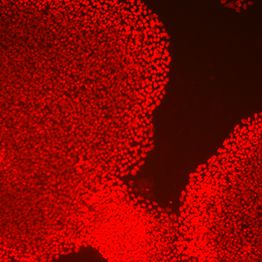iPSC Generation Service Details
Patient-derived iPS cells (induced Pluripotent Stem Cells) are great tools for developing biotherapeutic drugs, regenerative medicine, or disease modeling.
iPSC generation from various donor cell types:
- human: PBMCs, blood samples, fibroblast, HSC, MSCs, CD34+ cord blood, urine, and more
FAQs:
- Do you receive patient whole blood samples for iPSC generation? Do we need to perform any pathogen tests prior to shipping the samples to us?
(a) We ask that you send in pathogen test results before you send the blood samples to us.
(b) If you do not have pathogen test results, you can send the blood samples to us directly, and we will do the sample process and culture in a quarantine room for 1-2 weeks before we submit and get pathogen test results. A quarantine room fee is applied. Inquire for more details. - What will customers need to provide for iPSC generation from patient fibroblasts?
(a) For iPSC generation from patient fibroblasts, customers will need to provide 1 x 10^6 cells. - What is the minimum numbers of cells needed for iPSC generation from PBMCs?
(a) For iPSC generation from PBMCs, we will need 2 vials of 2-3 x 10^6 cells.
Standard Packaging:
- Ship 2 million frozen cells in cryovials (two (2) vials with 1 x 10^6 cells/vial) or live active cells in two or three (2 – 3) x T-75 flasks (70% confluence)
- With pathogen and SARS-CoV-2 test results
- Optional Pathogen Testing Service is available
- With pathogen and SARS-CoV-2 test results
- Provide enough media for 3-4 weeks of culturing, if special media/instructions are required.
Standard Deliverables:
- Two (2) iPSC clones with two (2) vials per clone at 1 x 10^6 cells/ vial
- Clones are characterized for three (3) pluripotency markers: OCT4, SOX2, SSEA4, TRA-1-60, TRA-1-81
- Karyotyping Data
- Additional characterization services are available.
- Final Report
Standard Workflow and Timeline:
| Service | Time |
|
1. Pathogen test (Optional)
|
1-2 weeks |
| 2. Cell recovery, expansion, and banking | 3-4 weeks |
|
3. Transfection with vectors and iPSC generation
|
3-4 weeks |
|
4. Colony picking, expansion, and cryopreservation
|
3-4 weeks |
|
5. iPSC characterization (standard)*
|
2-3 weeks |
|
Total
|
2-3 months |
* more detailed characterization options are available upon request
Required Starting Material & Information
Required Cell Line Sample Amount:
- Two (2) cryovials with 1 x 10^6 cells/vial; OR
- Live active cells in two or three (2 – 3) x T-75 flasks (70% confluence)
General Cell Line Information:
- Cell Name
- Cell Type (fibroblast, epithelial, suspension, adherent, etc.)
- Cell Origin, passage number, etc.
- If known, donor's age, disease condition
- Pathogen test and a COVID-19 test (if the sample was collected after December 2020)
- Optional Pathogen Testing Service is available
Specific Culture Conditions:
- Culture conditions, protocol, split ratio
- Please provide information on whether the cell line has been genetically modified. If so, what was the modification method (e.g., lentiviral vector)?
- Have you cultured/transfected the cells in the past? If so, what was the % efficiency?
- Can the cells be expanded from a single cell?
Additional Information For Skin Fibroblast Collection:
- "Kit" is not necessary. Simply leave the biopsy in a small tube filled with DMEM/10% FBS/1x antibiotics and ship it to us with blue ice
- 2mm x 2mm (at least) of dermal tissue (it will be great if the epidermis is removed)
- Store in DMEM/10% FBS/1x penicillin-streptomycin
- We recommend getting the biopsy from a normal soft (thinner epidermic) skin (no rash, no old scar, no tattoo, etc.) which is not always exposed to sunlight (UV) (to avoid any acquired mutation in the genome). For example, the skin behind the outer ear, near the armpit, etc. Try not to spill it when you open the bottle. Simply drop the tissue into the liquid. One or two small pieces (2mm x 2mm) of skin should be enough. The bigger, the better.
Applied StemCell can also genetically engineer iPSCs using CRISPR/Cas9 and provide expanded characterization and differentiation to somatic lineages such as NK cells, T cells, astrocytes, retinal pigment epithelium (RPE), cardiomyocytes, hepatocytes, and more.


